巴西狂欢节【英文】
巴西狂欢节的起源与盛大庆典
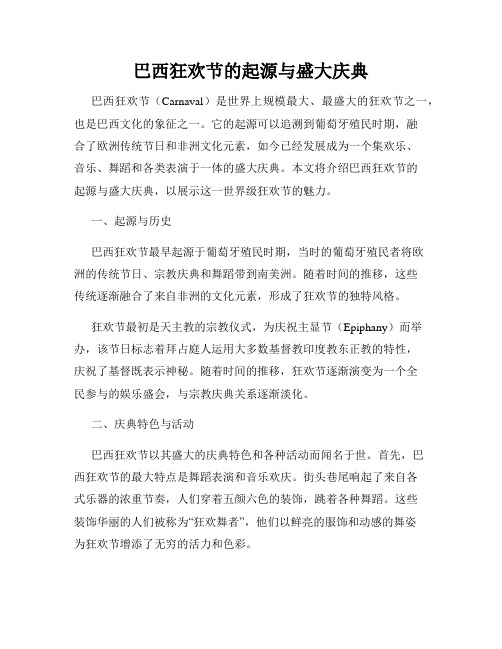
巴西狂欢节的起源与盛大庆典巴西狂欢节(Carnaval)是世界上规模最大、最盛大的狂欢节之一,也是巴西文化的象征之一。
它的起源可以追溯到葡萄牙殖民时期,融合了欧洲传统节日和非洲文化元素,如今已经发展成为一个集欢乐、音乐、舞蹈和各类表演于一体的盛大庆典。
本文将介绍巴西狂欢节的起源与盛大庆典,以展示这一世界级狂欢节的魅力。
一、起源与历史巴西狂欢节最早起源于葡萄牙殖民时期,当时的葡萄牙殖民者将欧洲的传统节日、宗教庆典和舞蹈带到南美洲。
随着时间的推移,这些传统逐渐融合了来自非洲的文化元素,形成了狂欢节的独特风格。
狂欢节最初是天主教的宗教仪式,为庆祝主显节(Epiphany)而举办,该节日标志着拜占庭人运用大多数基督教印度教东正教的特性,庆祝了基督既表示神秘。
随着时间的推移,狂欢节逐渐演变为一个全民参与的娱乐盛会,与宗教庆典关系逐渐淡化。
二、庆典特色与活动巴西狂欢节以其盛大的庆典特色和各种活动而闻名于世。
首先,巴西狂欢节的最大特点是舞蹈表演和音乐欢庆。
街头巷尾响起了来自各式乐器的浓重节奏,人们穿着五颜六色的装饰,跳着各种舞蹈。
这些装饰华丽的人们被称为“狂欢舞者”,他们以鲜亮的服饰和动感的舞姿为狂欢节增添了无穷的活力和色彩。
其次,巴西狂欢节还有著名的游行队伍和花车巡游。
各个社区和组织都会组织花车巡游,每个花车都由成百上千名狂欢的人们围绕着跳舞、欢呼、高歌,并表达对狂欢节的热爱和激情。
这些花车设计精美,装饰华丽,以具有代表性的主题和造型为特色,吸引了无数观众的目光。
此外,巴西狂欢节还有著名的面具和服饰。
狂欢节期间,人们会戴上各式各样的面具,这些面具代表着各种角色和神话传说中的人物。
人们也可以穿上各式各样的服装,如绚丽的装饰外套、华丽的羽毛头饰等,以展示自己的个性和独特风格。
三、巴西狂欢节的意义与影响巴西狂欢节不仅仅是一场娱乐活动,它还承载了巴西人民的文化认同和自豪感。
狂欢节象征着巴西人民欢乐、热情和团结的精神,每年吸引着数以百万计的游客和参与者,为巴西经济和旅游业带来巨大的收益。
南美洲的节日庆典热情与喜庆
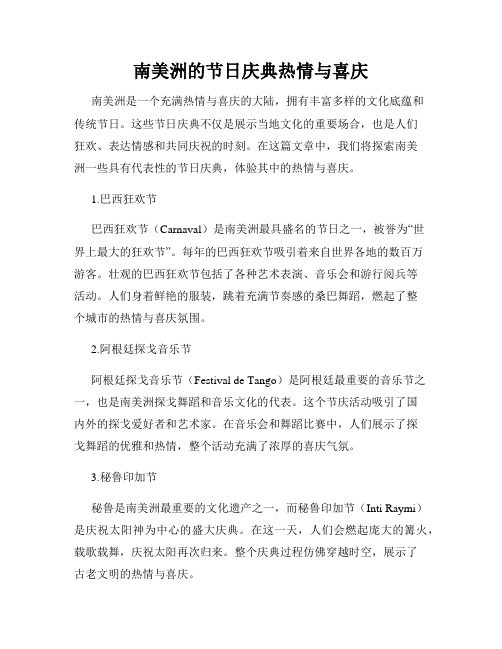
南美洲的节日庆典热情与喜庆南美洲是一个充满热情与喜庆的大陆,拥有丰富多样的文化底蕴和传统节日。
这些节日庆典不仅是展示当地文化的重要场合,也是人们狂欢、表达情感和共同庆祝的时刻。
在这篇文章中,我们将探索南美洲一些具有代表性的节日庆典,体验其中的热情与喜庆。
1.巴西狂欢节巴西狂欢节(Carnaval)是南美洲最具盛名的节日之一,被誉为“世界上最大的狂欢节”。
每年的巴西狂欢节吸引着来自世界各地的数百万游客。
壮观的巴西狂欢节包括了各种艺术表演、音乐会和游行阅兵等活动。
人们身着鲜艳的服装,跳着充满节奏感的桑巴舞蹈,燃起了整个城市的热情与喜庆氛围。
2.阿根廷探戈音乐节阿根廷探戈音乐节(Festival de Tango)是阿根廷最重要的音乐节之一,也是南美洲探戈舞蹈和音乐文化的代表。
这个节庆活动吸引了国内外的探戈爱好者和艺术家。
在音乐会和舞蹈比赛中,人们展示了探戈舞蹈的优雅和热情,整个活动充满了浓厚的喜庆气氛。
3.秘鲁印加节秘鲁是南美洲最重要的文化遗产之一,而秘鲁印加节(Inti Raymi)是庆祝太阳神为中心的盛大庆典。
在这一天,人们会燃起庞大的篝火,载歌载舞,庆祝太阳再次归来。
整个庆典过程仿佛穿越时空,展示了古老文明的热情与喜庆。
4.圣诞节的帕宗加 Parang圣诞节在整个南美洲都是一个重要的庆典。
在特立尼达和多巴哥的圣诞节,人们会举行Parang音乐庆典。
Parang 是一种具有浓厚西班牙和加勒比风格的传统音乐,表达了人们对圣诞节的喜庆和欢乐。
人们会随着Parang音乐唱歌、跳舞和享受美食,传递着热情和喜庆的祝福。
5.玛拉卡夏迪亚节玛拉卡夏迪亚节(La Fiesta de la Mare de Déu de la Salut)是玻利维亚托雷斯市最重要的传统庆典之一。
整个节庆活动持续一周,人们通过游行、音乐、舞蹈和烟花等庆典活动,向圣母玛利亚表达敬意和欢庆。
街头洒水和人们身穿传统服饰等仪式,将庆典气氛推向了高潮,热情与喜庆洋溢在整个城市。
巴西狂欢节活动方案
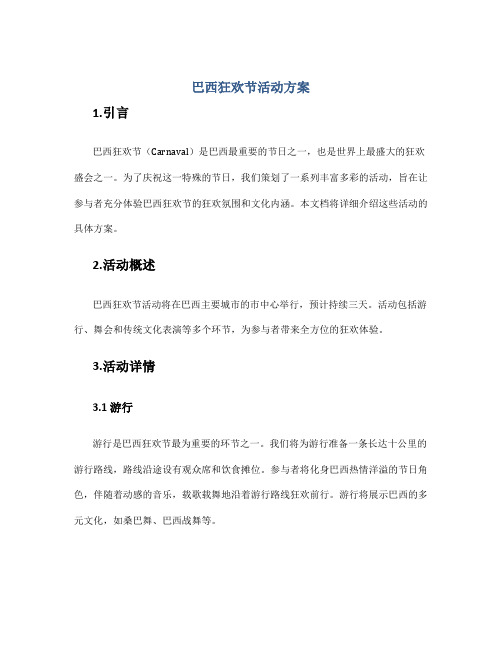
巴西狂欢节活动方案1.引言巴西狂欢节(Carnaval)是巴西最重要的节日之一,也是世界上最盛大的狂欢盛会之一。
为了庆祝这一特殊的节日,我们策划了一系列丰富多彩的活动,旨在让参与者充分体验巴西狂欢节的狂欢氛围和文化内涵。
本文档将详细介绍这些活动的具体方案。
2.活动概述巴西狂欢节活动将在巴西主要城市的市中心举行,预计持续三天。
活动包括游行、舞会和传统文化表演等多个环节,为参与者带来全方位的狂欢体验。
3.活动详情3.1 游行游行是巴西狂欢节最为重要的环节之一。
我们将为游行准备一条长达十公里的游行路线,路线沿途设有观众席和饮食摊位。
参与者将化身巴西热情洋溢的节日角色,伴随着动感的音乐,载歌载舞地沿着游行路线狂欢前行。
游行将展示巴西的多元文化,如桑巴舞、巴西战舞等。
3.2 舞会舞会是狂欢节的另一重要环节。
我们将在市中心的广场搭建一个巨大的舞台,供参与者跳舞和观看表演。
舞会将持续至深夜,有各种音乐表演和巡游,让参与者尽情释放自己,在动感的音乐中跳跃。
3.3 传统文化表演巴西狂欢节不仅仅是狂欢和娱乐,还承载了丰富的传统文化。
我们将邀请巴西本土的传统艺术表演团体,展示他们的才华和技艺。
参与者可以欣赏到桑巴舞、巴西战舞等传统舞蹈,感受巴西文化的魅力。
4.参与方式和费用巴西狂欢节活动对所有人开放,没有参与年龄限制。
参与者可以选择参加游行、舞会或观看传统文化表演。
活动期间,我们将设立多个参与点,参与者可以在场地现场购票参加或提前在线购票。
费用方面,游行和传统文化表演是免费开放的,而舞会则需要购买门票。
舞会门票的价格将根据舞会规模和明星表演嘉宾的数量有所不同,早期购票可以享受优惠价格。
5.安全措施为了确保参与者的安全,我们将采取以下安全措施:•为活动场地设立安全围栏,确保游行和舞会区域的秩序和安全。
•在游行和舞会现场增设安保人员,巡逻维持秩序。
•为参与者提供急救点,解决紧急医疗问题。
•发放活动指南,提醒参与者关注个人财物安全,避免失窃。
介绍巴西狂欢节的英语作文

Carnival in Brazil: A Rainbow of FestivitiesBrazil, a country renowned for its vibrant culture and rich heritage, celebrates one of the most exuberant and colorful festivals in the world - the Carnival. This festival, which takes place before the Lent season, is a time for revelry, music, dance, and an explosion of color and creativity.The Carnival in Brazil is not just a festival; it's an experience that transforms the country into a massive partyground. The streets are filled with costumed revelers, vibrant music, and an endless array of parades and performances. The samba, the national dance of Brazil, plays a pivotal role in the festivities, with its rhythmic beats and energetic moves that capture the essence of the Carnival.The Carnival season begins weeks before the actual festival, with preparation and anticipation building up to a fever pitch. The streets are decorated with bright lights and colorful banners, creating a festive atmosphere that is felt throughout the country.The highlight of the Carnival is the samba schools' parades. These parades, which are often months in preparation, feature thousands of dancers, musicians, and float operators who perform intricate routines set to the beat of samba drums. The costumes are as elaborate as the dances, with bright colors and intricate designs that reflect the theme of each school. The parades are a competition in themselves, with each school striving to outdo the others with their creativity and precision.But the Carnival is not just about the parades. It's also about the street parties, the music, and the food. The streets are filled with people of all ages, dancing, singing, and enjoying the moment. The music is a blend of samba, funk, and other Brazilian genres, creating a soundscape that is both upbeat and infectious. The food is also a highlight, with typical Brazilian dishes like feijoada, pao de queijo, and churrasco being served alongside international cuisines, satisfying the palates of all.The Carnival in Brazil is not just a celebration; it's a way of life. It's a time for people to forget theirworries, come together, and celebrate their culture and heritage. It's a time for dreams to come true and for imagination to run wild. And it's a time for the world to see the true spirit of Brazil - a country that knows how to party and celebrate life in all its colors and vibrancy.**巴西狂欢节:五彩斑斓的盛宴**巴西,这个以充满活力的文化和丰富的遗产而闻名的国家,庆祝着世界上最为喧闹和多彩的节日之一——狂欢节。
全球最盛大的庆典:巴西狂欢节
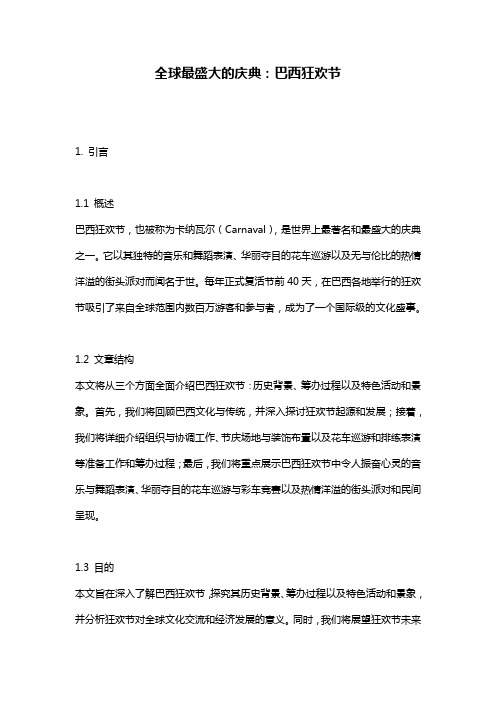
全球最盛大的庆典:巴西狂欢节1. 引言1.1 概述巴西狂欢节,也被称为卡纳瓦尔(Carnaval),是世界上最著名和最盛大的庆典之一。
它以其独特的音乐和舞蹈表演、华丽夺目的花车巡游以及无与伦比的热情洋溢的街头派对而闻名于世。
每年正式复活节前40天,在巴西各地举行的狂欢节吸引了来自全球范围内数百万游客和参与者,成为了一个国际级的文化盛事。
1.2 文章结构本文将从三个方面全面介绍巴西狂欢节:历史背景、筹办过程以及特色活动和景象。
首先,我们将回顾巴西文化与传统,并深入探讨狂欢节起源和发展;接着,我们将详细介绍组织与协调工作、节庆场地与装饰布置以及花车巡游和排练表演等准备工作和筹办过程;最后,我们将重点展示巴西狂欢节中令人振奋心灵的音乐与舞蹈表演、华丽夺目的花车巡游与彩车竞赛以及热情洋溢的街头派对和民间呈现。
1.3 目的本文旨在深入了解巴西狂欢节,探究其历史背景、筹办过程以及特色活动和景象,并分析狂欢节对全球文化交流和经济发展的意义。
同时,我们将展望狂欢节未来的发展前景和全球影响力。
通过阅读本文,读者将对巴西狂欢节有一个全面而深入的了解,从而提高他们对这一全球盛事的认识和欣赏程度。
2. 巴西狂欢节的历史背景:2.1 巴西文化与传统:巴西是一个多元文化国家,拥有丰富多样的民俗风情和宗教信仰。
这些文化和传统在巴西狂欢节中得到了充分展现。
巴西人民对音乐、舞蹈、美食以及庆祝活动有着热情洋溢的热爱,这些元素在狂欢节中展示出来。
巴西传统音乐如桑巴、博萨诺瓦以及弗雷沃等形式,在全球范围内享有声誉。
这些音乐通常伴随着动感的鼓点和华丽舞步,成为了巴西狂欢节不可或缺的一部分。
此外,巴西还因其建筑风格、美食文化和衣饰传统而闻名。
例如,里约热内卢市的山字形居民区-佩德拉达地区具有其特殊设计和色彩斑斓的外墙装饰,在巴西狂欢节期间被用作装饰背景。
同时,美味的费苏咖啡和阿萨伊水果碗等巴西特色美食也在节庆期间供应。
2.2 狂欢节的起源与发展:巴西狂欢节,又被称为卡纳瓦尔(Carnaval),起源于基督教的宗教庆典。
巴西狂欢节英文版课件

Propose disposal of waste generated during the Carnival is essential to prevent pollution and maintain environmental sustainability
Restoration of facilities
The Rio Carnival
Worldrenowned
The Carnival in Rio de Janeiro is one of the most famous carnivals in Brazil and also one of the largest carnivals in the world, attracting tourists from all over the world to participate.
Music and Dance
Music
Brazilian Carnival is owned for its upbeat samba music, which is the soundtrack of the celebration Other popular genes include marketing bands, funks, and electronic music
CharaБайду номын сангаасteristics and Features
Brazilian Carnival is known for its satellite atmosphere, extravagant costs, and lively music The festival typically lasts for several days, with different events and parks taking place in different parts of the country
舞蹈与狂欢巴西的圣保罗狂欢节与巡游
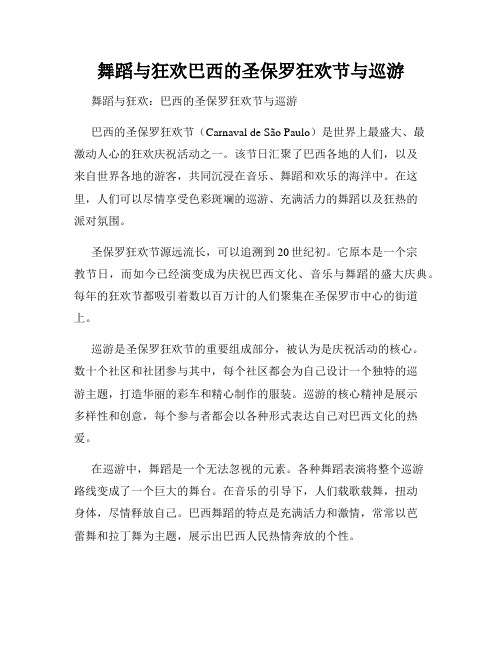
舞蹈与狂欢巴西的圣保罗狂欢节与巡游舞蹈与狂欢:巴西的圣保罗狂欢节与巡游巴西的圣保罗狂欢节(Carnaval de São Paulo)是世界上最盛大、最激动人心的狂欢庆祝活动之一。
该节日汇聚了巴西各地的人们,以及来自世界各地的游客,共同沉浸在音乐、舞蹈和欢乐的海洋中。
在这里,人们可以尽情享受色彩斑斓的巡游、充满活力的舞蹈以及狂热的派对氛围。
圣保罗狂欢节源远流长,可以追溯到20世纪初。
它原本是一个宗教节日,而如今已经演变成为庆祝巴西文化、音乐与舞蹈的盛大庆典。
每年的狂欢节都吸引着数以百万计的人们聚集在圣保罗市中心的街道上。
巡游是圣保罗狂欢节的重要组成部分,被认为是庆祝活动的核心。
数十个社区和社团参与其中,每个社区都会为自己设计一个独特的巡游主题,打造华丽的彩车和精心制作的服装。
巡游的核心精神是展示多样性和创意,每个参与者都会以各种形式表达自己对巴西文化的热爱。
在巡游中,舞蹈是一个无法忽视的元素。
各种舞蹈表演将整个巡游路线变成了一个巨大的舞台。
在音乐的引导下,人们载歌载舞,扭动身体,尽情释放自己。
巴西舞蹈的特点是充满活力和激情,常常以芭蕾舞和拉丁舞为主题,展示出巴西人民热情奔放的个性。
在巴西狂欢节期间,圣保罗的街道变成了一个庞大的舞蹈场。
无数的游客和当地居民汇聚在一起,共同参与这场前所未有的盛宴。
他们手牵手、肩并肩,随着音乐的节奏扭动身体,沉浸在欢乐的氛围中。
舞蹈成为了一种无声的交流方式,超越语言和文化的界限,将人们紧密地联系在一起。
除了巡游和舞蹈,圣保罗狂欢节还有许多其他活动。
各种街头音乐表演、艺术展览、文化市集等等充实了整个庆典。
在这里,人们可以尽情体验巴西的独特魅力,感受到这个国家的活力与热情。
圣保罗狂欢节是一个令人难以忘怀的盛宴,它不仅是庆祝巴西文化的场所,也是人们欢聚一堂、忘却烦忧的地方。
无论是年轻人还是老年人,无论是巴西人还是外国人,每个人都可以找到自己在这里尽情狂欢的方式。
总而言之,圣保罗狂欢节以其独特的舞蹈和欢乐氛围,吸引着无数人们的关注和参与。
巴西狂欢节英语介绍

巴西狂欢节英语介绍Brazil's Carnival is a world-renowned festival celebrated with exuberant energy and vibrant colors. It is an annualevent that takes place in the days leading up to theChristian season of Lent, which is why it is often referredto as the "greatest show on Earth." Here's an introduction to this spectacular celebration:The origins of the Brazilian Carnival can be traced backto the 18th century when European Catholic traditions merged with African and indigenous Brazilian customs. The festivalis marked by street parties, masquerade balls, and samba parades, with Rio de Janeiro's Carnival being the most famous.The Carnival typically lasts for several days, with the most intense celebrations occurring on the three days before Ash Wednesday. Each day is filled with a variety of events, including street performances known as "blocos," which are organized by different neighborhoods and often feature live music and dancing.One of the most iconic aspects of the Carnival is the samba parade, where samba schools from across Brazil competein a highly competitive and choreographed event. Theseschools spend all year preparing for their performances,which are judged based on their music, dance, and elaborate costumes.Costumes are a significant part of the Carnival experience. Participants often wear elaborate and colorful outfits, with many choosing to disguise themselves with masks. The costumes are a reflection of the creativity and artistic expression that is so integral to the festival.In addition to the visual spectacle, the BrazilianCarnival is also a feast for the ears. The music is a fusionof various rhythms and styles, with samba being the most prominent. The infectious beats and melodies are impossibleto resist, often drawing even the most reserved individuals into the dance.The Carnival is not just a Brazilian phenomenon; it has become a global event that attracts millions of tourists each year. People from all over the world come to experience the unique blend of culture, music, and community that definesthis extraordinary festival.In summary, the Brazilian Carnival is a celebration of life, freedom, and creativity. It is a time when the streetsof Brazil come alive with music, dance, and joy, offering a glimpse into the rich cultural tapestry that makes Brazilsuch a fascinating country. Whether you're there in person or experiencing it through the lens of media, the Brazilian Carnival is an unforgettable event that showcases the best of what this South American nation has to offer.。
巴西狂欢节

巴西狂欢节的发展
• 里约热内卢最早的狂欢节游行并无音乐节奏亦无旋律,而只是狂喊和 狂笑,以及疯狂地互相投掷液体和物品。有一年狂欢节,一些葡萄牙 人把大鼓和几个小鼓带到大街上敲得震耳欲聋,把大群人吸引到街上 。这大概可以说是狂欢节的起始。后来渐渐形成了一些装束、化妆雷 同的团体上街狂欢游行,其中也有不少是黑人。这些黑人团体把非洲 音乐舞蹈开始引入狂欢节。
• 桑巴舞最早流行于巴西的巴伊亚州首府萨尔瓦多一带,这里是葡萄牙 人最早在巴西登陆殖民的地方。被贩卖到种植园里和采矿场的黑奴, 在繁重的劳动之余,以跳这种家乡舞苦中作乐。他们的舞蹈也就逐渐 吸收了来自欧洲的波希米亚的波尔卡舞、来自古巴的哈巴涅拉舞和巴 西当地流行的马克西克歇舞的一些因素,逐渐形成桑巴舞。 • 20世纪初,是巴伊亚州的妇女们将这种舞蹈带到当时的巴西首都里约 热内卢。1928年,巴西的第一座桑巴舞学校“让人去说闲话”在里约 热内卢建立。1932年,巴西举行首次情人节桑巴舞游行观摩比赛,受 到人们的欢迎和好评。从此,现代桑巴舞很快就风靡巴西全国。
• 桑巴舞起源于非洲。“桑巴”一词据说从非洲的安哥拉第二大部族基 姆本杜语中的"森巴"演变而来。“森巴”原本是一种激昂的肚皮舞。 顾名思义,这种舞蹈以上下抖动腹部、摇动臀部为主要特征。这是安 哥拉最流行的一种舞蹈动作,后来随着贩卖黑奴活动的兴起而开始向 外传播,从16世纪30年代到19世纪中叶的300多年中,葡萄牙殖民者从 安哥拉和非洲其他地区向巴西贩卖黑奴1200万。在把黑奴塞进船舱运 往新发现的大陆拉丁美洲的时候,白人奴隶贩子担心路途遥远,黑奴 在船舱中一窝几十天,到岸时腿脚不灵便,卖不出好价钱。因此,他 们就每天把拥挤在船舱中的黑奴赶到甲板上,以敲打酒桶和铁锅为伴 奏,让他们跳一通森巴舞,活动筋骨。这样,殖民者本想增强黑奴这 种特殊商品的竞价力的举动,就把这种流行于非洲的舞蹈无意中带到 拉丁美洲。
巴西狂欢节热情洋溢的盛大庆典

巴西狂欢节热情洋溢的盛大庆典巴西狂欢节(Carnaval)是全世界最大、最著名的狂欢节庆之一。
这项庆典每年吸引着来自世界各地的游客,他们齐聚在巴西的大街小巷中,享受热情洋溢、充满活力的节日氛围。
巴西狂欢节不仅是庆祝活动,更是巴西文化的一部分,它是一场庆祝生命和快乐的盛大庆典。
巴西狂欢节起源于欧洲的文化传统,这一庆典最早可追溯到16世纪。
在该地区殖民化的过程中,西班牙和葡萄牙的移民将欧洲的狂欢节风俗带到了巴西,并结合了当地的传统和宗教元素,形成了独特而丰富多彩的狂欢节庆典。
如今,巴西狂欢节已经发展成为一项复杂而庞大的活动,涵盖了音乐、舞蹈、游行、装饰和大型表演等多个方面。
巴西狂欢节的核心活动是游行,这是一场由各个独立组织或社团组织的规模宏大的活动。
游行的参与者称为“狂欢者”,他们会身着各种华丽的服装,头戴华盛顿巴克斯(Washington Bacchus)或其他角色的面具,载歌载舞,用欢呼声、鼓乐和音乐来庆贺狂欢节的到来。
巴西狂欢节的游行通常沿着市中心的主要街道进行,路旁会有成千上万的观众,为游行的参与者加油助威。
音乐是巴西狂欢节不可或缺的一部分。
巴西人民热爱音乐,他们在狂欢节期间会欢聚一堂,共同跳舞、唱歌,享受音乐的魅力。
巴西音乐以其节奏感强和富有活力的风格而闻名,尤其是萨尔萨(Salsa)和桑巴(Samba)两种舞曲风格在巴西狂欢节中占据了重要地位。
音乐表演通常在特定的地点进行,吸引着大量的游客和当地居民。
除了游行和音乐表演,巴西狂欢节还有其他值得一提的活动。
其中最著名的是女王选美比赛,这是一场评选最美丽和最具魅力女性的活动。
参赛者会穿上华丽的服装,展示自己的才艺和优雅。
在这个比赛中,女性们有机会成为巴西狂欢节的女王,并为狂欢节增添更多的魅力和色彩。
巴西狂欢节的氛围是非常开放和包容的,每个人都可以参与其中,无论是年轻人还是老人,无论是身世高贵或是普通民众。
这种狂欢节的精神充满了团结、和谐和庆祝生命的热情。
高中英语 Module 4 Carnival Section Ⅰ Warming UpP

Module 4 Carnival巴西狂欢节被称为世界上最大的狂欢节,让我们阅读下面的文章一起走进巴西狂欢节吧。
The annual Carnival in Brazil is a unique festival.It is also the most important ethnic celebration.It comes between the end of February and the beginning of March every year.Hundreds of thousands of tourists from overseas were attracted to join the feast.The earliest Carnival dates back to 1641:people would be encouraged to parade,dance and drink to celebrate the birthday of the Portuguese King.More than three hundred years later,the Carnival has become the most important folk festival of Brazil.On February 24th of this year,the “King Momo” dressed in bright orange,took the gold key of the city from the mayor of Rio De Janeiro,to signify the beginning of Carnival.During the following five days,the “King”,who plays a leading role in the Carnival,would throw out all daily routines,so that people could indulge themselves.“King Momo”is also known as“the King of Carnival”.He is hand-picked by Rio residents.There was once a rule that required the “King”to weigh no less than 100kg.Today,there is a rule that the “King”shouldn't be heavier than 130kg.Seven hundred thousand tourists gathered in the coastal city of Rio De Janeiro for Carnival.Whoever they are-poor or rich,celebrity or ordinary people- they are all just dancers,day and night.Happiness prevails,while complaints disappear.[阅读障碍词]1.annual adj.每年的2.ethnic adj.种族的,民族的3.signify v.象征4.indulge vt.放纵5.prevail vt.盛行[诱思导读]1. Why did people celebrate carnival long long ago?To celebrate the birthday of the Portuguese King.2.Who selected the “King Momo”?Rio residents.Ⅰ.匹配下列单词的词性及汉语意思( )1.hide A.n.记忆( )2.confusion B.n.杂乱;混乱( )3.extend C.n.魅力;魔力( )4.pretend D.vt.掩藏;躲藏( )5.memory E.vt.延长( )6.wander F.vi.假装( )7.elegant G.vi.漫步;闲逛( )8.magic H.adj.优美的;高雅的[答案]1-4 DBEF 5-8 AGHCⅡ.选择下列句中相应词组的汉语意思and went to the party as she used to.2.The sun came out from behind the clouds late in the afternoon.3.You are sure to have fun at the party tonight.4.We have to wait until the discussion between them comes to an end.5.The traditional friendship between our two countries dates back to ancient days.6.The two young lovers decided to marry in secret,and they did so the very next day.[答案]1-3 CAF 4-6 BGEThe Magic of the MaskThink of carnival,and you think of crowds,costumes,and confusion①.The sounds and sights change from one country to another but the excitement is the same everywhere.面具的魔力想到狂欢节,你就会想到人群、服装和混乱。
探索南美洲的传统习俗
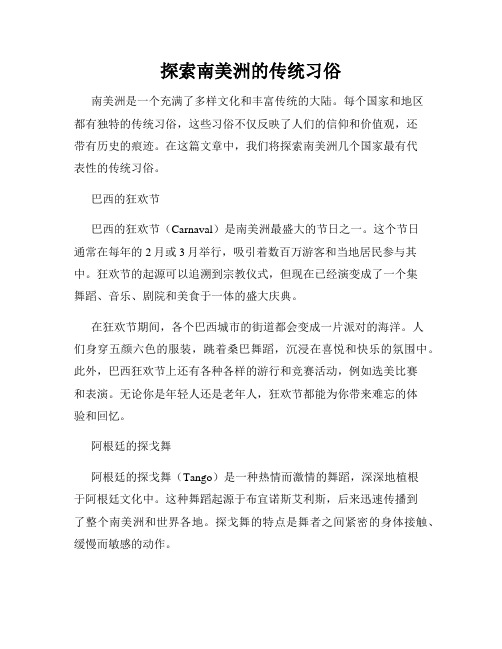
探索南美洲的传统习俗南美洲是一个充满了多样文化和丰富传统的大陆。
每个国家和地区都有独特的传统习俗,这些习俗不仅反映了人们的信仰和价值观,还带有历史的痕迹。
在这篇文章中,我们将探索南美洲几个国家最有代表性的传统习俗。
巴西的狂欢节巴西的狂欢节(Carnaval)是南美洲最盛大的节日之一。
这个节日通常在每年的2月或3月举行,吸引着数百万游客和当地居民参与其中。
狂欢节的起源可以追溯到宗教仪式,但现在已经演变成了一个集舞蹈、音乐、剧院和美食于一体的盛大庆典。
在狂欢节期间,各个巴西城市的街道都会变成一片派对的海洋。
人们身穿五颜六色的服装,跳着桑巴舞蹈,沉浸在喜悦和快乐的氛围中。
此外,巴西狂欢节上还有各种各样的游行和竞赛活动,例如选美比赛和表演。
无论你是年轻人还是老年人,狂欢节都能为你带来难忘的体验和回忆。
阿根廷的探戈舞阿根廷的探戈舞(Tango)是一种热情而激情的舞蹈,深深地植根于阿根廷文化中。
这种舞蹈起源于布宜诺斯艾利斯,后来迅速传播到了整个南美洲和世界各地。
探戈舞的特点是舞者之间紧密的身体接触、缓慢而敏感的动作。
探戈舞以其情感表达和技巧复杂性而闻名。
在舞蹈中,舞者需要通过身体的亲密接触传达情感,同时还需要准确地完成各种技巧要求。
探戈舞不仅是一种乐趣,更是一种艺术形式,它让人们能够展示自己的创造力和情感。
秘鲁的印加文化秘鲁是南美洲最有特色的国家之一,拥有悠久的印加文化。
在秘鲁,人们仍然保留着许多古老的传统习俗,这些习俗向世人展示了古代印加文明的美丽和神秘。
印加文化的重要组成部分是庆典和仪式。
例如,印加人会举行色彩斑斓的仪式,以感谢大自然的恩赐。
这些仪式通常涉及到音乐、舞蹈和仪式品,象征着对土地的崇敬和感激之情。
此外,秘鲁的文化还表现在手工艺品和美食上。
秘鲁人以其独特的编织技巧和细致精美的手工艺品而闻名,例如羊毛纺织品和陶器。
在美食方面,秘鲁料理以其多样性和口感丰富而受到赞誉,例如传统的烤玉米和鱼料理。
总结南美洲的传统习俗跨越了历史和地理的界限,展示了其多样性和独特性。
南美洲的传统节庆与游行
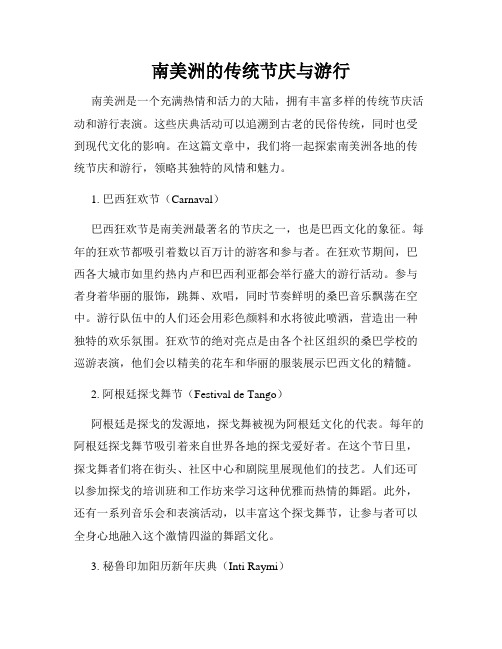
南美洲的传统节庆与游行南美洲是一个充满热情和活力的大陆,拥有丰富多样的传统节庆活动和游行表演。
这些庆典活动可以追溯到古老的民俗传统,同时也受到现代文化的影响。
在这篇文章中,我们将一起探索南美洲各地的传统节庆和游行,领略其独特的风情和魅力。
1. 巴西狂欢节(Carnaval)巴西狂欢节是南美洲最著名的节庆之一,也是巴西文化的象征。
每年的狂欢节都吸引着数以百万计的游客和参与者。
在狂欢节期间,巴西各大城市如里约热内卢和巴西利亚都会举行盛大的游行活动。
参与者身着华丽的服饰,跳舞、欢唱,同时节奏鲜明的桑巴音乐飘荡在空中。
游行队伍中的人们还会用彩色颜料和水将彼此喷洒,营造出一种独特的欢乐氛围。
狂欢节的绝对亮点是由各个社区组织的桑巴学校的巡游表演,他们会以精美的花车和华丽的服装展示巴西文化的精髓。
2. 阿根廷探戈舞节(Festival de Tango)阿根廷是探戈的发源地,探戈舞被视为阿根廷文化的代表。
每年的阿根廷探戈舞节吸引着来自世界各地的探戈爱好者。
在这个节日里,探戈舞者们将在街头、社区中心和剧院里展现他们的技艺。
人们还可以参加探戈的培训班和工作坊来学习这种优雅而热情的舞蹈。
此外,还有一系列音乐会和表演活动,以丰富这个探戈舞节,让参与者可以全身心地融入这个激情四溢的舞蹈文化。
3. 秘鲁印加阳历新年庆典(Inti Raymi)Inti Raymi是秘鲁传统印加庆典的一部分,每年在六月份庆祝。
这个节日用来纪念太阳神,是印加文化中最重要的节日之一。
在庆典期间,人们会穿着传统服饰,举行盛大的游行和表演仪式。
表演者会进行各种舞蹈、歌唱和古老仪式的再现,以向太阳神表示敬意。
庆典的最高潮是皇帝(Inca)的登场,他将通过一系列祈祷和仪式来保障丰收和幸福。
4. 委内瑞拉梅里达狂欢节(Feria De Mérida)委内瑞拉梅里达狂欢节是南美洲最古老的节庆之一,传统已有四个世纪之久。
这个狂欢节的特点是由城市的各个社区组成的各色队伍和舞团,以及丰富多样的艺术表演和民俗活动。
狂欢节巴西的热情派对与文化庆典
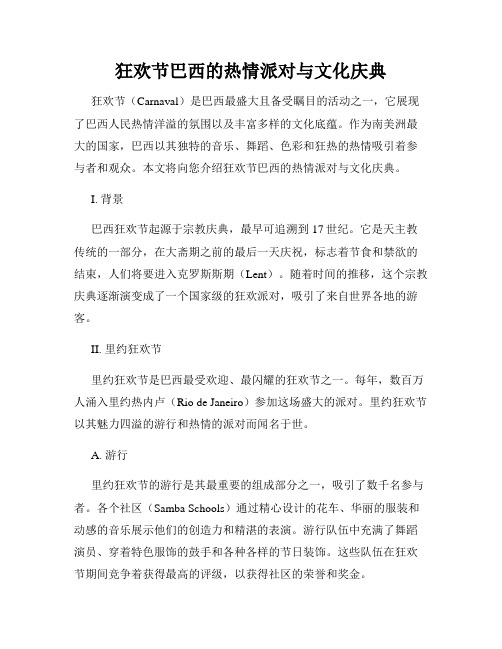
狂欢节巴西的热情派对与文化庆典狂欢节(Carnaval)是巴西最盛大且备受瞩目的活动之一,它展现了巴西人民热情洋溢的氛围以及丰富多样的文化底蕴。
作为南美洲最大的国家,巴西以其独特的音乐、舞蹈、色彩和狂热的热情吸引着参与者和观众。
本文将向您介绍狂欢节巴西的热情派对与文化庆典。
I. 背景巴西狂欢节起源于宗教庆典,最早可追溯到17世纪。
它是天主教传统的一部分,在大斋期之前的最后一天庆祝,标志着节食和禁欲的结束,人们将要进入克罗斯斯期(Lent)。
随着时间的推移,这个宗教庆典逐渐演变成了一个国家级的狂欢派对,吸引了来自世界各地的游客。
II. 里约狂欢节里约狂欢节是巴西最受欢迎、最闪耀的狂欢节之一。
每年,数百万人涌入里约热内卢(Rio de Janeiro)参加这场盛大的派对。
里约狂欢节以其魅力四溢的游行和热情的派对而闻名于世。
A. 游行里约狂欢节的游行是其最重要的组成部分之一,吸引了数千名参与者。
各个社区(Samba Schools)通过精心设计的花车、华丽的服装和动感的音乐展示他们的创造力和精湛的表演。
游行队伍中充满了舞蹈演员、穿着特色服饰的鼓手和各种各样的节日装饰。
这些队伍在狂欢节期间竞争着获得最高的评级,以获得社区的荣誉和奖金。
B. 大本营里约狂欢节的活动主要集中在里约热内卢的圣本笃广场(Sambódromo)和Copacabana海滩。
圣本笃广场是一个巨大的露天竞技场,可以容纳数万名观众。
在这里,游行队伍将表演他们的创意和才能,让观众陶醉其中。
Copacabana海滩是一个开放的场所,游客们可以在那里尽情跳舞、享受音乐和参加各种派对。
III. 地方狂欢节除了里约狂欢节外,巴西还有许多其他地方举办的狂欢节活动,各自散发着独特的魅力和特色。
A. 萨尔瓦多狂欢节作为巴西最古老的狂欢节之一,萨尔瓦多狂欢节在巴西的热情派对中占有重要地位。
这个节日融合了非洲文化、音乐和舞蹈元素,呈现出独特的风格。
carnaval与carnival的区别用法

carnaval与carnival的区别用法在全球范围内,有许多节日和庆典活动都源于欧洲文化,Carnaval和Carnival便是其中的代表。
尽管这两个词在拼写上仅有细微差别,但它们的用法和起源却大相径庭。
在这篇文章中,我们将探讨Carnaval和Carnival的区别,以帮助大家更好地了解这两个节日。
首先,我们来了解一下Carnaval和Carnival的词源及起源。
Carnaval这个词源于拉丁语,意为“告别肉食”,寓意着在斋戒期前的狂欢庆祝。
Carnival则源于葡萄牙语,意为“狂欢节”。
这两个词都有狂欢、庆祝的意象,但它们的起源和用法却有所不同。
在用法上,Carnaval和Carnival的区别主要体现在以下几点。
首先,Carnaval通常用于指代巴西的狂欢节,是世界上最具盛名的狂欢节之一。
而Carnival则可以泛指各种狂欢节,包括但不仅限于巴西的狂欢节。
其次,Carnaval更注重宗教氛围,庆典活动中常有宗教仪式和表演。
而Carnival则更侧重于民间习俗和喜庆氛围,庆典活动包括民间舞蹈、音乐、戏剧等。
在举办时间和地点上,Carnaval和Carnival也有明显差异。
Carnaval通常在每年的二月或三月举行,时间相对固定。
而Carnival则没有固定的时间,各地的举办时间根据当地习俗和传统而有所不同。
此外,Carnaval主要在巴西等国家举行,而Carnival则在世界各地都有举办,包括欧洲、北美洲、南美洲等地区。
尽管Carnaval和Carnival在起源、用法和举办时间上存在差异,但它们在文化内涵和活动形式上有很多相似之处。
两者都有浓厚的民间习俗和宗教氛围,庆典活动中都包括丰富的音乐、舞蹈、戏剧等表演。
因此,在参加这些庆典活动时,无论是选择Carnaval还是Carnival,都能感受到浓厚的文化底蕴和欢乐氛围。
最后,我们来总结一下何时使用Carnaval或Carnival。
巴西狂欢节英文作文

巴西狂欢节英文作文英文,Brazilian Carnival is one of the most famous festivals in the world. It is a time of celebration, music, dance, and colorful costumes. The carnival is held every year before Lent, which is a time of fasting and sacrificein the Christian religion.During the carnival, the streets of Brazil are filled with people dancing to the rhythm of samba music. Theparade is the highlight of the carnival, where sambaschools compete with each other to create the best floats and costumes. The parade is a visual feast, with bright colors, feathers, and sequins.Apart from the parade, there are also street partiesand balls where people can dance and have fun. The carnival is a time of joy and happiness, where people forget their worries and enjoy life to the fullest.中文,巴西狂欢节是世界上最著名的节日之一。
这是一个庆祝、音乐、舞蹈和色彩缤纷的时刻。
巴西文化热情奔放的狂欢节
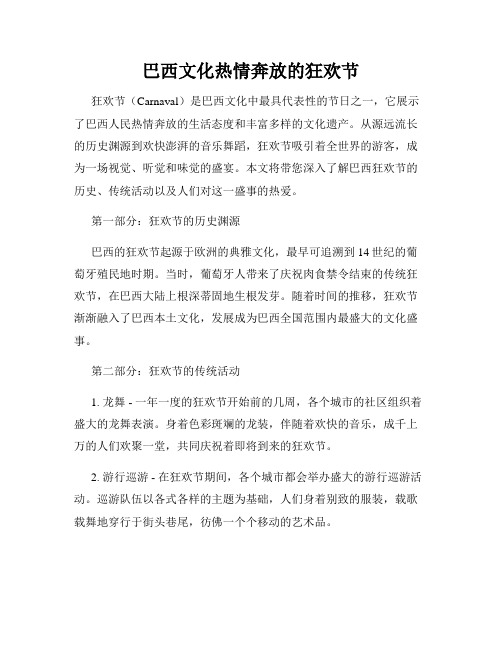
巴西文化热情奔放的狂欢节狂欢节(Carnaval)是巴西文化中最具代表性的节日之一,它展示了巴西人民热情奔放的生活态度和丰富多样的文化遗产。
从源远流长的历史渊源到欢快澎湃的音乐舞蹈,狂欢节吸引着全世界的游客,成为一场视觉、听觉和味觉的盛宴。
本文将带您深入了解巴西狂欢节的历史、传统活动以及人们对这一盛事的热爱。
第一部分:狂欢节的历史渊源巴西的狂欢节起源于欧洲的典雅文化,最早可追溯到14世纪的葡萄牙殖民地时期。
当时,葡萄牙人带来了庆祝肉食禁令结束的传统狂欢节,在巴西大陆上根深蒂固地生根发芽。
随着时间的推移,狂欢节渐渐融入了巴西本土文化,发展成为巴西全国范围内最盛大的文化盛事。
第二部分:狂欢节的传统活动1. 龙舞 - 一年一度的狂欢节开始前的几周,各个城市的社区组织着盛大的龙舞表演。
身着色彩斑斓的龙装,伴随着欢快的音乐,成千上万的人们欢聚一堂,共同庆祝着即将到来的狂欢节。
2. 游行巡游 - 在狂欢节期间,各个城市都会举办盛大的游行巡游活动。
巡游队伍以各式各样的主题为基础,人们身着别致的服装,载歌载舞地穿行于街头巷尾,彷佛一个个移动的艺术品。
3. 舞龙舞狮 - 舞龙舞狮是狂欢节期间观众最喜爱的传统表演之一。
在街头广场上,舞者们扮成华服的龙和狮子,以惊人的身法和鼓舞人心的鼓点表演,带给观众们一种神秘而震撼的视觉享受。
4. 音乐节 - 狂欢节是音乐的盛宴,巴西各地的表演者会带来不同类型的音乐演出,从萨尔萨舞曲到巴西低音吉他,从放克音乐到巴西蓝调,让人们沉浸其中感受音乐的魅力。
第三部分:狂欢节的象征意义狂欢节象征着巴西人民无忧无虑的生活态度和对生活的热爱。
在这个节日里,人们追求快乐,忘却困难和烦恼。
无论是穿着华丽的服饰、舞动身姿,还是参与各种活动,人们借狂欢节的契机,释放自己内心深处的激情和喜悦。
第四部分:狂欢节对巴西旅游业的影响巴西的狂欢节每年吸引着无数的游客慕名而来,给巴西旅游业带来巨大的经济效益。
游客们可以在狂欢节期间亲身参与各项活动,感受到巴西人民的热情好客。
Carnival in Brazil-巴西狂欢节
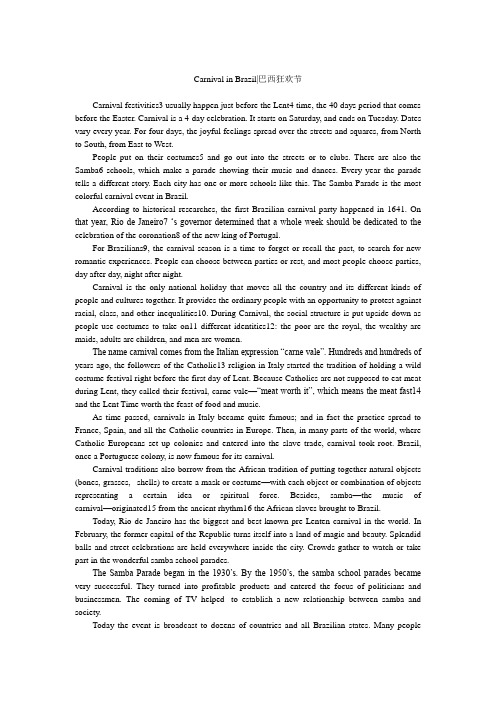
Carnival in Brazil|巴西狂欢节Carnival festivities3 usually happen just before the Lent4 time, the 40 days period that comes before the Easter. Carnival is a 4-day celebration. It starts on Saturday, and ends on Tuesday. Dates vary every year. For four days, the joyful feelings spread over the streets and squares, from North to South, from East to West.People put on their costumes5 and go out into the streets or to clubs. There are also the Samba6 schools, which make a parade showing their music and dances. Every year the parade tells a different story. Each city has one or more schools like this. The Samba Parade is the most colorful carnival event in Brazil.According to historical researches, the first Brazilian carnival party happened in 1641. On that year, Rio de Janeiro7 ‘s governor determined that a whole week should be dedicated to the celebration of the coronation8 of the new king of Portugal.For Brazilians9, the carnival season is a time to forget or recall the past, to search for new romantic experiences. People can choose between parties or rest, and most people choose parties, day after day, night after night.Carnival is the only national holiday that moves all the country and its different kinds of people and cultures together. It provides the ordinary people with an opportunity to protest against racial, class, and other inequalities10. During Carnival, the social structure is put upside down as people use costumes to take on11 different identities12: the poor are the royal, the wealthy are maids, adults are children, and men are women.The name carnival comes from the Italian expression “carne vale”. Hundreds and hundreds of years ago, the followers of the Catholic13 religion in Italy started the tradition of holding a wild costume festival right before the first day of Lent. Because Catholics are not supposed to eat meat during Lent, they called their festival, carne vale—“meat worth it”, which means the meat fast14 and the Lent Time worth the feast of food and music.As time passed, carnivals in Italy became quite famous; and in fact the practice spread to France, Spain, and all the Catholic countries in Europe. Then, in many parts of the world, where Catholic Europeans set up colonies and entered into the slave trade, carnival took root. Brazil, once a Portuguese colony, is now famous for its carnival.Carnival traditions also borrow from the African tradition of putting together natural objects (bones, grasses, shells) to create a mask or costume—with each object or combination of objects representing a certain idea or spiritual force. Besides, samba—the music of carnival—originated15 from the ancient rhythm16 the African slaves brought to Brazil.Today, Rio de Janeiro has the biggest and best known pre-Lenten carnival in the world. In February, the former capital of the Republic turns itself into a land of magic and beauty. Splendid balls and street celebrations are held everywhere inside the city. Crowds gather to watch or take part in the wonderful samba school parades.The Samba Parade began in the 1930’s. By the 1950’s, the samba school parades became very successful. They turned into profitable products and entered the focus of politicians and businessmen. The coming of TV helped to establish a new relationship between samba and society.Today the event is broadcast to dozens of countries and all Brazilian states. Many peoplethink of it as the greatest show on earth.狂欢节是巴西最著名节日,每年盛夏时节,巴西狂欢节都要吸引成千上万游客从世界各地来到这里。
- 1、下载文档前请自行甄别文档内容的完整性,平台不提供额外的编辑、内容补充、找答案等附加服务。
- 2、"仅部分预览"的文档,不可在线预览部分如存在完整性等问题,可反馈申请退款(可完整预览的文档不适用该条件!)。
- 3、如文档侵犯您的权益,请联系客服反馈,我们会尽快为您处理(人工客服工作时间:9:00-18:30)。
•Amerindian (0.1%).[5]
The
Districts of Rio downtown (centro): the
Rio - Marvelous City: Zona Sul
historic hub of Rio. There is much culture to be enjoyed here including historic churches, landmarks, the national library, •The and museums. It is also the financial center of the community, where some of Brazil’s largest state companies are located
„has booming tourism attractions including cultural, like museums, theaters, operas, ballets or typical entertainment like beaches, where the wealthy can windsurf and sail, and bars, nightclubs, and cinemas
•15% of the city's 6 million inhabitants lives in poverty
•Many with low schooling, unemployed, or homeless
The favelas are troubled by„ •widespread drug-related crime •gang warfare •police brutality •lack of sanitation and other poverty-related social issues.
Though Rio is one of the richest areas in all of brazil, the reality of the poverty Is ripe here, especially with the economic prosperity. Quote: “Brazil is not a poor country, but a country of many poor”
Carnival In Rio
Fun & Politics
State of Rio de Janeiro
• Portuguese for "River of January" •City Limits: 1,182.3 square kilometres (456.5 sq mi) •Metro area population: 11.5 million Capital of the state of Rio was the capital of Brazil (1763–1960) and of the Portuguese Empire (1808–1821)
City Population: 6 million+
•Known for its African-influenced samba music and carnival celebrations
Population
•European (56%) •Mixed-race (32.3%) •Black African (11.4%) •Asian (0.1%)
RIO DE JANIERO„
„Has large industries in high tech items, agriculture, and livestock etc „Income distribution unequal, economic growth has benefited very few. The workforce, which is the backbone of industry, live in hillside shanty towns
„is also nicknamed A Cidade Maravilhosa translated to "The Marvelous City"
CARNIVAL: ORIGINS
• Ancient Greece • In honor of Dionysus, god of wine. • Came to Rome. In honor of Bacchus, the Roman equivalent. • Roman Catholic Church modified it into a festival before Ash Wednesday. • This turned into your last chance to indulge in alcohol, sex, music, and food. • Carne Vale - Latin for, “farewell to the flesh”.
பைடு நூலகம்
Districts of Rio
North Zone: some tourism, housing, Estádio do Maracanã, •The a high capacity soccer venue; Galeão - International Airport, and Universidade Federal do Rio de Janeiro • The West Zone: This part is where the stark differences between the classes can be seen best, There are industrial parts and agricultural parts and some are experiencing accelerated growth. FAVELAS – Shantytowns of Rio de Janeiro
•
The South Zone: a Tourist hub, home to some of Rio’s famous beaches, where Copacabana hosts one of the largest new year’s celebrations in the world.; also home to Pontifícia Universidade Católica do Rio de Janeiro, a famous catholic university.
